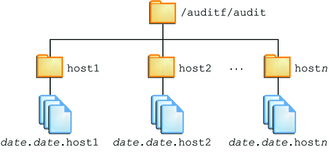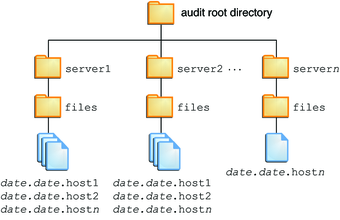| Skip Navigation Links | |
| Exit Print View | |

|
System Administration Guide: Security Services Oracle Solaris 10 1/13 Information Library |
| Skip Navigation Links | |
| Exit Print View | |

|
System Administration Guide: Security Services Oracle Solaris 10 1/13 Information Library |
1. Security Services (Overview)
Part II System, File, and Device Security
2. Managing Machine Security (Overview)
3. Controlling Access to Systems (Tasks)
4. Controlling Access to Devices (Tasks)
5. Using the Basic Audit Reporting Tool (Tasks)
6. Controlling Access to Files (Tasks)
7. Using the Automated Security Enhancement Tool (Tasks)
Part III Roles, Rights Profiles, and Privileges
8. Using Roles and Privileges (Overview)
9. Using Role-Based Access Control (Tasks)
10. Role-Based Access Control (Reference)
Part IV Cryptographic Services
13. Oracle Solaris Cryptographic Framework (Overview)
14. Oracle Solaris Cryptographic Framework (Tasks)
15. Oracle Solaris Key Management Framework
Part V Authentication Services and Secure Communication
16. Using Authentication Services (Tasks)
19. Using Secure Shell (Tasks)
21. Introduction to the Kerberos Service
22. Planning for the Kerberos Service
23. Configuring the Kerberos Service (Tasks)
24. Kerberos Error Messages and Troubleshooting
25. Administering Kerberos Principals and Policies (Tasks)
26. Using Kerberos Applications (Tasks)
27. The Kerberos Service (Reference)
Part VII Auditing in Oracle Solaris
28. Oracle Solaris Auditing (Overview)
29. Planning for Oracle Solaris Auditing
30. Managing Oracle Solaris Auditing (Tasks)
31. Oracle Solaris Auditing (Reference)
Files Used in the Audit Service
Rights Profiles for Administering Auditing
Auditing and Oracle Solaris Zones
This section provides information about the following commands:
The following list summarizes the tasks of the auditd daemon:
Opens and closes audit files in the directories that are specified in the audit_control file. The files are opened in order of mention.
Loads one or more plugins. Sun provides two plugins. The audit_binfile.so plugin writes binary audit data to a file. The audit_syslog.so plugin delivers selected text summaries of audit records to the syslog log
Reads audit data from the kernel and outputs the data by using an auditd plugin.
Executes the audit_warn script to warn of various conditions. The audit_binfile.so plugin executes the audit_warn script. The script, by default, sends warnings to the audit_warn email alias and to the console. The syslog.so plugin does not execute the audit_warn script.
By default, when all audit directories are full, processes that generate audit records are suspended. In addition, the auditd daemon writes a message to the console and to the audit_warn email alias. At this point, only the system administrator can fix the audit service. The administrator can log in to write audit files to offline media, delete audit files from the system, and do other cleanup tasks.
The audit policy can be reconfigured with the auditconfig command.
The auditd daemon can be started automatically when the system is booted into multiuser mode. Or, you can start the daemon from the command line. When the auditd daemon is started, it calculates the amount of free space that is necessary for audit files.
The auditd daemon uses the list of audit directories in the audit_control file as possible locations for creating audit files. The daemon maintains a pointer into this list of directories, starting with the first directory. Every time the auditd daemon needs to create an audit file, the daemon puts the file into the first available directory in the list. The list starts at the auditd daemon's current pointer. You can reset the pointer to the beginning of the list by running the audit -s command. The audit -n command instructs the daemon to switch to a new audit file. The new file is created in the same directory as the current file.
The audit command controls the actions of the auditd daemon. The audit command can do the following tasks:
Enable and disable auditing
Reset the auditd daemon
Write audit records to a different audit file
For a discussion of the available options, see the audit(1M) man page.
The bsmrecord command displays the format of audit events that are defined in the /etc/security/audit_event file. The output includes the event's audit ID, audit class, audit flag, and the record's audit tokens in order. With no option, the bsmrecord output displays in a terminal window. With the -h option, the output is suitable for viewing in a browser. For examples of the use of the bsmrecord command, see How to Display Audit Record Formats. Also, see the bsmrecord(1M) man page.
The auditreduce command summarizes audit records that are stored in binary format. The command can merge audit records from one or more input audit files. The command can also be used to perform a post selection of audit records. The records remain in binary format. To merge the entire audit trail, run this command on the audit server. The audit server is the system that mounts all the audit file systems for the installation. For more information, see the auditreduce(1M) man page.
The auditreduce command enables you to track all audited actions on multiple systems from a single location. The command can read the logical combination of all audit files as a single audit trail. You must identically configure all systems at a site for auditing, and create servers and local directories for the audit files. The auditreduce command ignores how the records were generated or where the records are stored. Without options, the auditreduce command merges audit records from all the audit files in all of the subdirectories in the audit root directory. Typically, /etc/security/audit is the audit root directory. The auditreduce command sends the merged results to standard output. You can also place the results into a single, chronologically ordered output file. The file contains binary data.
The auditreduce command can also select particular types of records for analysis. The merging functions and selecting functions of the auditreduce command are logically independent. The auditreduce command captures data from the input files as the records are read, before the files are merged and then written to disk.
By specifying options to the auditreduce command, you can also do the following:
Request audit records that were generated by specified audit classes
Request audit records that were generated by one particular user
Request audit records that were generated on specific dates
With no arguments, the auditreduce command checks the subdirectories within the /etc/security/audit directory, the default audit root directory. The command checks for a files directory in which the start-time.end-time.hostname files reside. The auditreduce command is very useful when audit data resides in separate directories. Figure 31-1 illustrates audit data in separate directories for different hosts. Figure 31-2 illustrates audit data in separate directories for different audit servers.
Figure 31-1 Audit Trail Storage Sorted by Host

Figure 31-2 Audit Trail Storage Sorted by Server

If the partition for the /etc/security/audit directory is very small, you might not store audit data in the default directory. You can pass the auditreduce command another directory by using the -R option:
# auditreduce -R /var/audit-alt
You can also specify a particular subdirectory by using the -S option:
# auditreduce -S /var/audit-alt/host1
For other options and more examples, see the auditreduce(1M) man page.
The praudit command makes the binary output of the auditreduce command readable. The praudit command reads audit records in binary format from standard input and displays the records in a presentable format. The input can be piped from the auditreduce command or from a single audit file. Input can also be produced with the cat command to concatenate several files, or the tail command for a current audit file.
The praudit command can generate four output formats. A fifth option, -l (long), prints one audit record per line of output. The default is to place one audit token per line of output. The -d option changes the delimiter that is used between token fields and between tokens. The default delimiter is a comma.
Default – The praudit command with no options displays one audit token per line. The command displays the audit event by its description, such as the ioctl(2) system call. Any value that can be displayed as text is displayed in text format. For example, a user is displayed as the user name, not as the user ID.
–r option – The raw option displays as a number any value that could be numeric. For example, a user is displayed by user ID, Internet addresses are in hexadecimal format, and modes are in octal format. The audit event is displayed as its event number, such as 158.
–s option – The short option displays the audit event by its table name, for example, AUE_IOCTL. The option displays the other tokens as the default option displays them.
–x option – The XML option displays the audit record in XML format. This option is useful as input to browsers, or as input to scripts that manipulate XML.
The XML is described by a DTD that the audit service provides. Oracle Solaris software also provides a style sheet. The DTD and the style sheet are in the /usr/share/lib/xml directory.
In the default output format of the praudit command, each record is easily identified as a sequence of audit tokens. Each token is presented on a separate line. Each record begins with a header token. You could, for example, further process the output with the awk command.
Here is the output from the praudit -l command for a header token:
header,173,2,settppriv(2),,example1,2010-10-10 10:10:02.020 -07:00
Here is the output from the praudit -r command for the same header token:
121,173,2,289,0x0000,192.168.86.166,1066077962,174352445
Example 31-1 Processing praudit Output With a Script
You might want to process output from the praudit command as lines of text. For example, you might want to select records that the auditreduce command cannot select. You can use a simple shell script to process the output of the praudit command. The following simple example script puts one audit record on one line, searches for a user-specified string, then returns the audit file to its original form.
#!/bin/sh # ## This script takes an argument of a user-specified string. # The sed command prefixes the header tokens with Control-A # The first tr command puts the audit tokens for one record # onto one line while preserving the line breaks as Control-A # praudit | sed -e '1,2d' -e '$s/^file.*$//' -e 's/^header/^aheader/' \\ | tr '\\012\\001' '\\002\\012' \\ | grep "$1" \\ Finds the user-specified string | tr '\\002' '\\012' Restores the original newline breaks
Note that the ^a in the script is Control-A, not the two characters ^ and a. The prefix distinguishes the header token from the string header that might appear as text.
The auditconfig command provides a command-line interface to retrieve and set audit configuration parameters. The auditconfig command can do the following tasks:
Display, check, and configure audit policy
Determine if auditing is turned on or turned off
Manage the audit directory and the audit file
Manage the audit queue
Get and set preselection masks
Get and set audit event to audit class mappings
Get and set configuration information, such as session ID and audit ID
Configure audit characteristics for a process, a shell, and a session
Reset audit statistics
For a discussion of the command options, see the auditconfig(1M) man page.